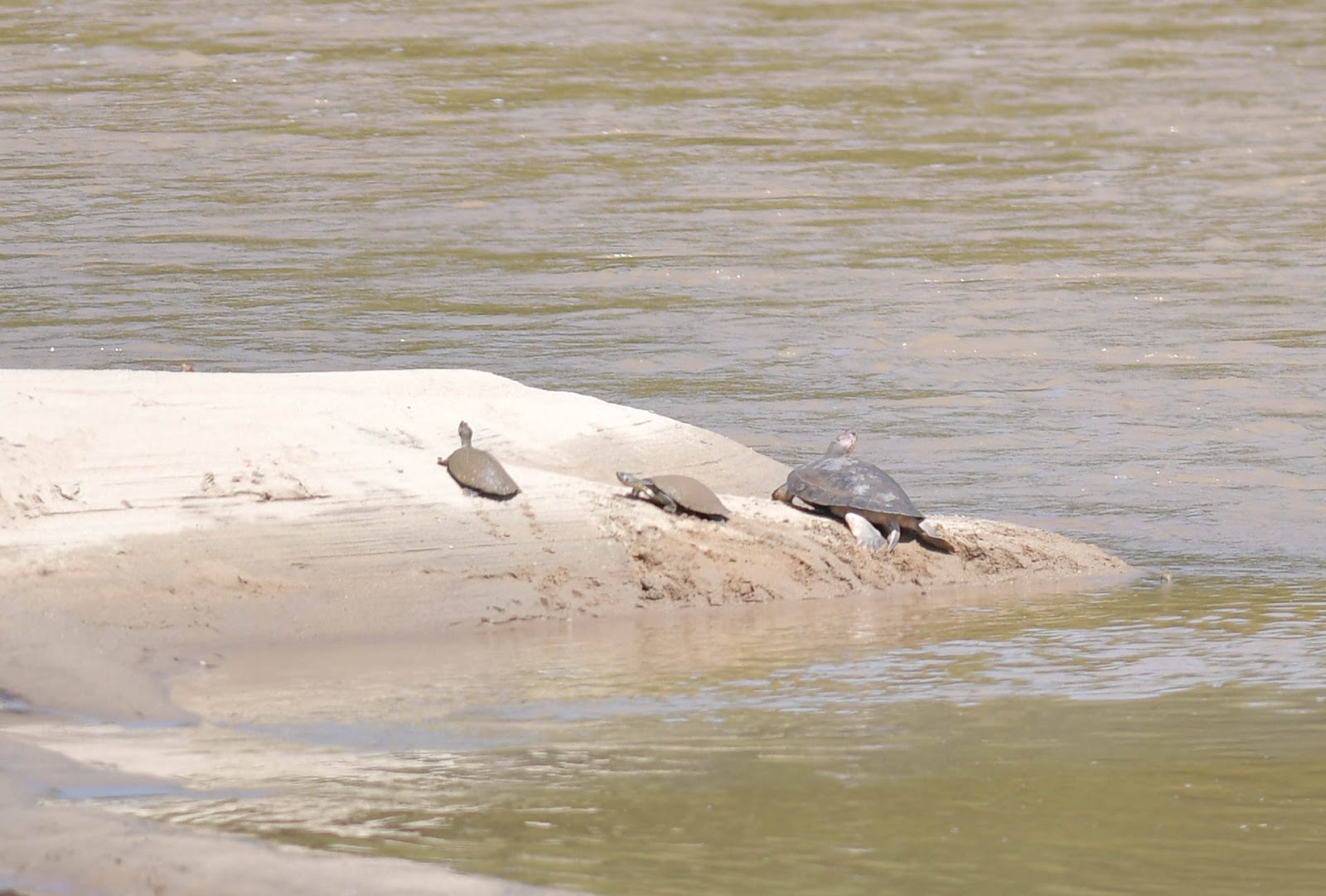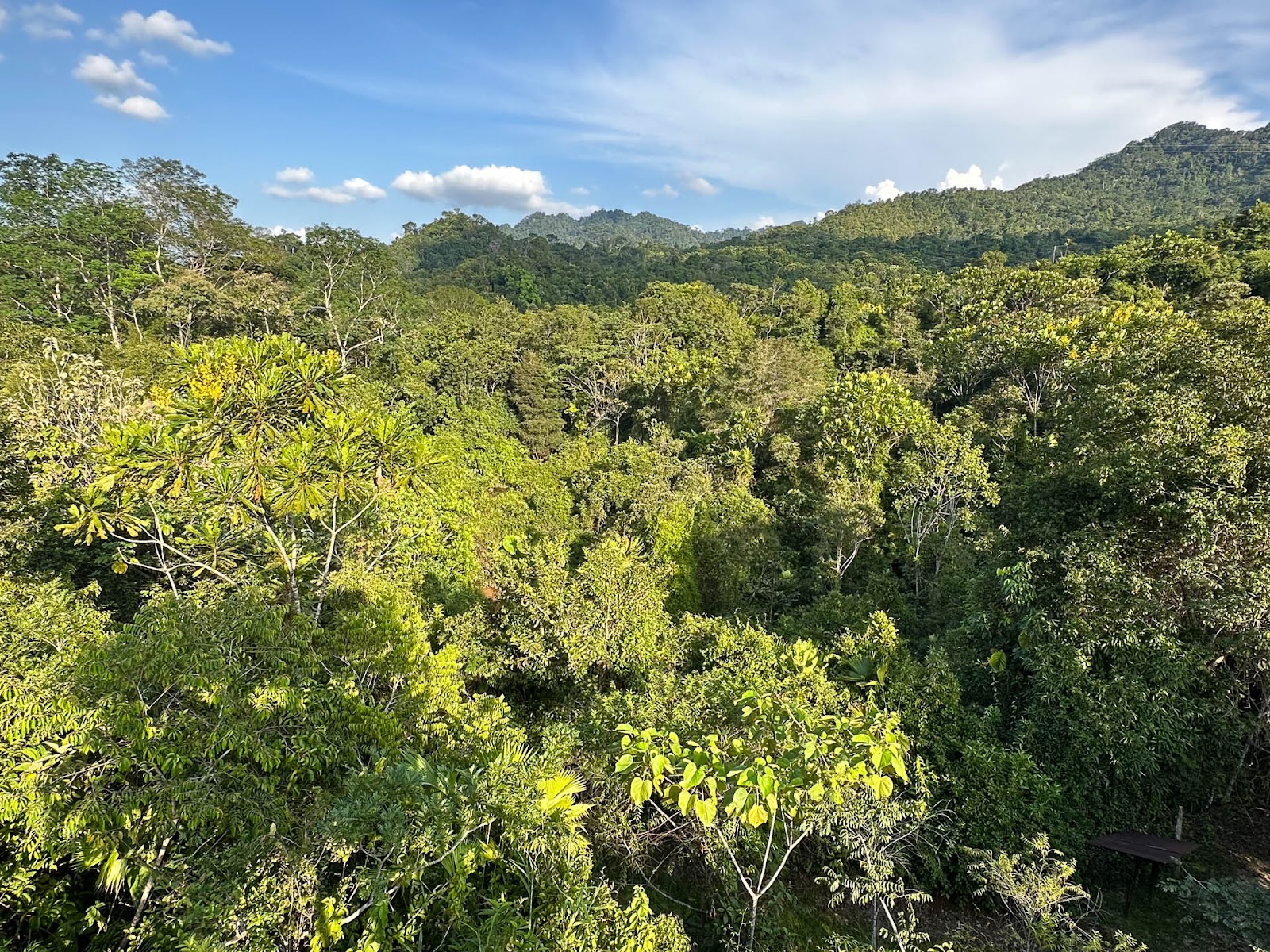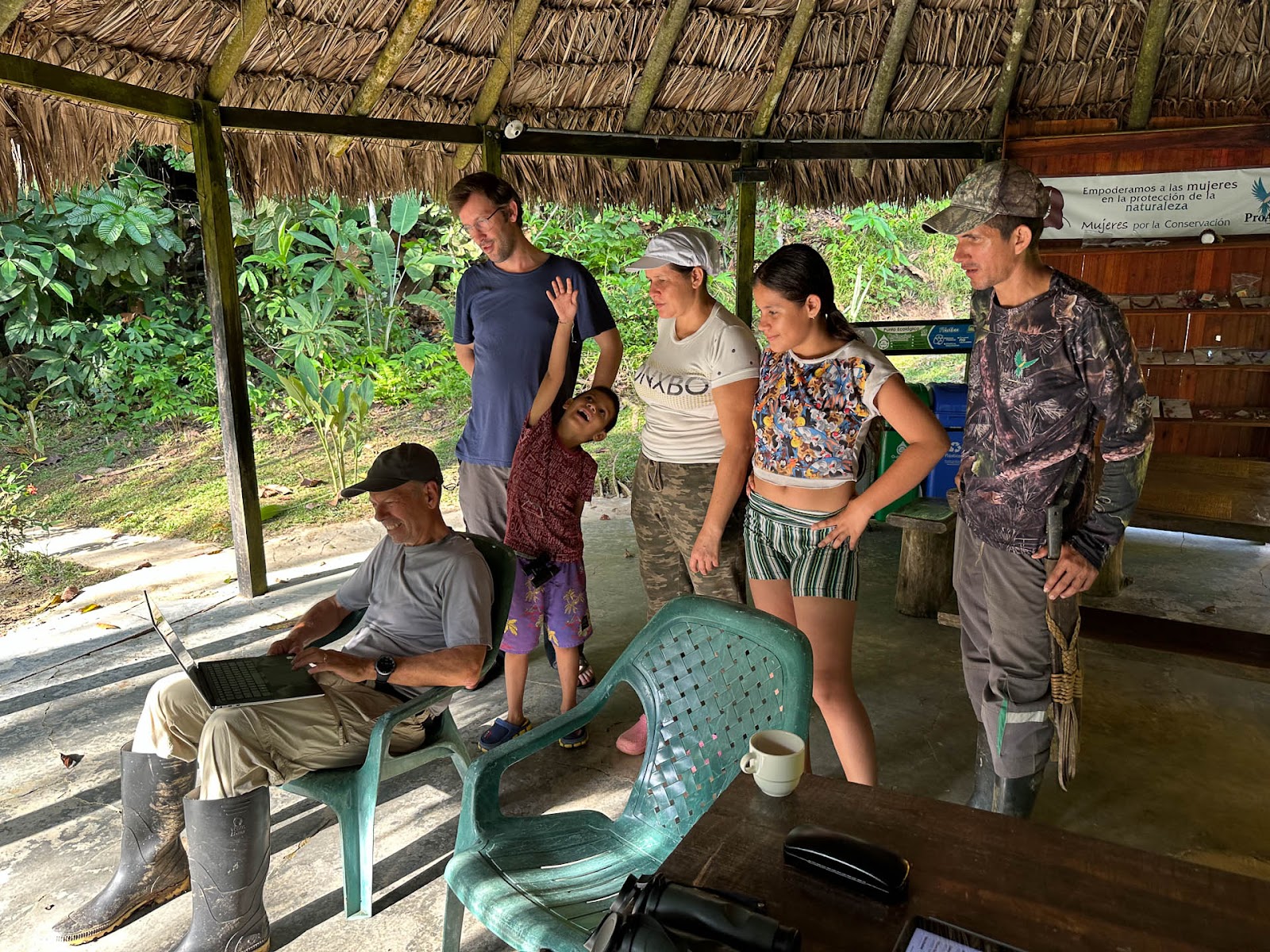The last leg of Mission Monkey with Rob Smith of "Wild About Colombia" is underway! We have seen 17 species of primates so far, can we reach 20 species? On December 19, we left Bogota at 4:30 in the morning to avoid rush-hour traffic for the 6-hour drive to the Rio Claro Nature Reserve. We stopped near Rio Claro to look for Silvery-brown Tamarins along a dirt track. Unfortunately, the road led to a quarry where giant dump trucks full of rocks went rumbling past. It was hard to imagine finding tamarins here and as I feared we did not. We arrived at the Canon del Rio Claro Nature Reserve and had lunch before checking into our cabin. That afternoon we met Rob and Arturo, our new local guide to look for tamarins along the reserve road. We walked to one end and then the other finding our first Red-tailed Squirrels but frustratingly no tamarins.
 |
| Red-tailed Squirrel |
As dusk approached we decided to walk to a cave where Oilbirds are known to roost. On the path were many local tourists. They come here to raft the Rio Claro, explore nearby caves, or swim in the river. Once we passed the dormitory-style accommodations, the trail was quiet and pleasant. Just before sunset, we reached the cave which was on the other side of the river. A waterfall was cascading from the entrance but we could hear the birds squawking inside. As it got dark they trickled out, then more and more, maybe 100, flew out! It was challenging to get a good view as we didn’t want to shine our lights on them. Marc managed to get a decent photo of some Oilbirds as they flew out of the cave.
 |
| Oilbirds |
They are strange birds, the only member of the order Steatornithiformes. Their behavior was more bat-like in that they are nocturnal and one of the few birds to use echolocation to navigate. We could hear their clicks as they flew around the mouth of the cave. Unlike their closest relatives, nightjars, they eat fruit and not insects. So, why are they called Oilbirds? The answer is not very pleasant. In the past chicks were captured and boiled down to make oil. Thankfully this practice no longer occurs.
We left the cave and spotlighted back to the lodge. Rob picked up a rat in the beam of his spotlight, most likely in the genus of South American spiny rats, Proechimys.
 |
| South American Spiny Rat |
There were some other creepy crawlers like spiders and this Dusky-handed Tailless Whip Scorpion.
 |
| Dusky-handed Tailless Whip Scorpion |
After dinner, we continued to spotlight down the road where Rob found this cute mouse opossum at the base of a tree. It was later identified by small mammal enthusiast Venkat Sankar as Marmosops chucha. It’s a newly described species and doesn’t have a common name.
 |
| Marmosops chucha |
Early the next morning we walked the reserve road in search of the tamarins but they were nowhere to be found. We returned to the “quarry road” where Rob was certain we’d find them but I had my doubts with all the dump trucks rumbling past. Rob’s persistence paid off and he found them not long after we had set off! The Silvery-brown Tamarins are another Colombian endemic, found here and nowhere else on the planet! They are listed as vulnerable by the IUCN. The Magdalena River Valley is Colombia’s most threatened habitat. Most of the forest has been cleared for human habitation, cattle ranching, coca plantations, and mining. There’s no shortage of cement factories. Despite all this disturbance here was a troop of beautiful Silvery-brown Tamarins giving us the rare privilege of visiting them!
 |
| Silvery-brown Tamarin |
After breakfast, we left for our next destination, El Paujil Reserve. We reached the town of Dos y Medio where we stopped for the customary ice cream before turning off on a dirt track. Along the way, we were treated to many river turtles basking in the sun including the critically endangered Magdalena River Turtle.
 |
| Magdalena River Turtles |
In the early afternoon, we reached the gate to El Paujil Reserve. Vehicles can no longer make it down to the lodge as the road had been partially washed away during a recent flood. Fortunately, we were met by rangers Elkin and Andrés who shuttled our duffels to the lodge on their motorcycles. We put on our wellies for the steep, slippery descent.
 |
| El Paujil Reserve |
When we arrived at the lodge, a male Blue-billed Curassow was perched on one of the dining area tables! The reserve was purchased by ProAves, a Colombian NGO to protect these critically endangered and endemic birds. In fact, “El Paujil” is the local name for these mysterious birds, little was known about them prior to 2003.
 |
| Blue-billed Curassow |
That afternoon we made the 500-foot climb back up to the ridge to search for our next two primate targets: the Brown Spider Monkey and the Varied White-fronted Capuchin. Rob, Marc, and I headed southwest along the main track and Arturo headed north. About 20 minutes later, Andrés and Arturo pull up excitedly on a motorcycle. They had found a large troop of Varied Capuchins! Rob said we should continue north to look for the spider monkeys as they are harder to find. I deferred somewhat hesitantly to his judgment. The afternoon wore on and we had yet to find a primate. Had we made the wrong decision? We turned a corner and came to a spot with an open view of the forest below. Suddenly, Rob shouts “spider monkeys!”. There were two in a tall ceiba tree about 300-400 meters away. It was far but they were in the open giving us a great view of these critically endangered monkeys. Are you sensing a theme here? Yes, many birds and animals in the Magdalena Valley are critically endangered with extinction and we were overjoyed to see them and help in their conservation efforts. Rob was thrilled to have found these monkeys so quickly. I was too! We watched them until they dropped down out of view.
 |
| Brown Spider Monkey |
On the way back, we ran into the Varied Capuchins so we got both targets our first afternoon. The Varied Capuchin is also endemic to Colombia and is endangered.
 |
| Varied Capuchin |
We made a quick visit to an observation tower overlooking this precious 8000-acre reserve protecting some of the last remaining lowland forest in the Magdalena Valley and its rare inhabitants.
 |
| View from the Tower |
After dinner, we set off on a night walk. We stopped at the observation tower to see if there were any mouse opossums at the hummingbird feeders but there were none. Rob did spot a nice Brown-eared Woolly Opossum for us.
 |
| Brown-eared Woolly Opossum |
We explored the Cano Trail but it was very muddy and very quiet other than frogs. We returned to our cabin for some rest after a very exhilarating day!
Now that the pressure of finding our two main primate targets was off, we could spend a relaxing day in the reserve. It didn’t mean we’d stop our search for monkeys and other mammals but we could do it at a more relaxed pace. We climbed to the ridge and walked to the “spider monkey viewpoint”. All was quiet at this hour but we decided to wait to see if the monkeys would show. Sure enough, as the sun warmed the forest one made an appearance then another. They actually came closer to the road and joined other members of their group! We followed them getting great views and photos. Marc was able to capture an agile individual in mid-leap!
 |
| Leaping Brown Spider Monkey |
Further down the road, we encountered the Varied Capuchins. What a treat to spend quality time with these two species of rare and endangered monkeys!
 |
| Varied Capuchin |
The show wasn’t over yet. Rob took us to a tree where Gray-handed Night Monkeys were roosting, another new species for us. These vulnerable and nocturnal monkeys peered groggy-eyed from their nest cavity so we didn’t linger long.
 |
| Gray-handed Night Monkeys |
Our final morning at El Paujil was spent in the dining area watching both male and female Blue-billed Curassows. It’s amazing to have these critically endangered birds calmly walking about with no fear of humans now that they’re not being hunted. Central American Agoutis and Gray-cowled Wood-rails were also feeding on seed that Andrés had put out.
 |
| Central American Agouti |
We showed Monica, Elkin, and their children Marc’s amazing photo of the leaping Brown Spider Monkey. It was rewarding to share our photos with this family who work so hard to keep this reserve going. The flood that occurred in June caused a lot of damage to the buildings and infrastructure of the reserve. In just 5 months, Elkin and Andrés were able to make the repairs so that guests can once again visit El Paujil.
 |
| Reviewing Photos |
We made the final climb to our vehicle and drove back to Dos y Medio where we dropped Arturo off. We continued on to Los Colores where we spent our final night with Rob. Mission Monkey was a huge success! We were able to see 21 species of primates, many endemic and endangered, in their natural habitat. Along the way, we met many Colombians working to protect the forest home of these monkeys and other endangered animals and birds. It was a privilege to be among the first foreign visitors to some of the fincas and reserves dedicated to conservation and ecotourism. A big thanks go to Rob Smith and Claudia Díaz of "Wild About Colombia" for making this trip possible and working out all the logistics. We wish them continued success with sharing Colombia’s rare and endemic primates with others! There’s still so much to see in this biodiverse country, we’ll be back!
We hope all is well with everyone,
Peggy and Marc
Our route map:
Colombia Mammal List: December 5 to 26, 2022
| No. | Species | Scientific Name | Comments |
| 1 | Colombian Squirrel Monkey | Saimir i cassiquiarensis albigena | ssp. of Humbolt’s Squirrel Monkey |
| 2 | Ornate Titi Monkey | Plecturocebus ornatus | endemic & vulnerable |
| 3 | Brumback’s Night Monkey | Aotus brumbacki | endemic & vulnerable |
| 4 | Colombian Woolly Monkey | Lagothrix lagotricha lugens | endemic & critically endangered |
| 5 | White-bellied Spider Monkey | Ateles belzebuth | endangered |
| 6 | Linne’s Two-toed Sloth | Choloepus didactylus | |
| 7 | Common Woolly Monkey | Lagothrix lagothricha lagothricha | vulnerable |
| 8 | Black-capped Capuchin | Sapajua apella | Tufted Capuchin |
| 9 | Colombian Red Howler | Alouatta seniculus | |
| 10 | Collared Titi Monkey | Cheracebus lugens | Black Titi |
| 11 | O’Connell’s Spiny Rat | Proechimys oconnelli | |
| 12 | Lowland Tapir | Tapirus terrestris | |
| 13 | Southern Opossum | Didelphis marsupialis | |
| 14 | Black-headed Uacari | Cacajao melanocephalus | Golden-backed Uacari |
| 15 | Black Agouti | Dasyprocta fuliginosa | |
| 16 | Mottled-face Tamarin | Saguinus inustus | “El Diablito” |
| 17 | Lesser Dog-like Bat | Peropteryx macrotis | |
| 18 | Common Vampire Bat | Desmodus rotundus | |
| 19 | Lesser Spear-nosed Bat | Phyllostomus elongatus | |
| 20 | Seba’s Short-tailed Bat | Carollia perspicillata | most likely |
| 21 | Southern Tamandua | Tamandua tetradactyla | |
| 22 | Orinoco River Dolphin | Inia geoffrensis humboldtiana | Boto |
| 23 | Ecuadorian Squirrel Monkey | Saimiri cassiquiarensis macrodon | ssp. of Humbolt’s Squirrel Monkey |
| 24 | Black Mantle Tamarin | Leontocebus nigricollis | |
| 25 | Red Titi Monkey | Plecturocebus discolor | White-tailed Titi |
| 26 | Miller’s Saki | Pithecia milleri | vulnerable |
| 27 | Colombian Black-handed Titi | Cheracebus medemi | endemic & vulnerable |
| 28 | South American Coati | Coati nasua | only guides saw |
| 29 | Greater Sac-winged Bat | Saccopteryx bilineata | |
| 30 | Lesson’s Saddle-back Tamarin | Leontocebus fuscus | |
| 31 | Western Pygmy Marmoset | Cebuella pygmaea | vulnerable |
| 32 | Caqueta Titi Monkey | Plecturocebus caquetenis | endemic & critically endangered |
| 33 | Red-tailed Squirrel | Sciurus granatensis | |
| 34 | Silvery-brown Tamarin | Saguinus leucopus | endemic & vulnerable |
| 35 | Brown Spider Monkey | Ateles hybridus | critically endangered |
| 36 | Spiny Rat | Proechimys sp.? | |
| 37 | Mouse Opossum | Marmosops chucha | newly described |
| 38 | Varied White-fronted Capuchin | Cebus versicolor | endemic & endangered |
| 39 | Gray-handed Night Monkey | Aotus griseimembra | Vulnerable |
| 40 | Central American Agouti | Dasyprocta punctata | |
| 41 | Brown-eared Woolly Opossum | Caluromys lanatus | |
| 42 | Dusky Rice Rat | Melanoyps caliginosus |


No comments:
Post a Comment